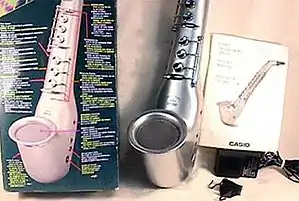Casio digital horn
The Digital Horn is a musical instrument produced by Casio in the mid-1980s.

Models
The original model was presented as either the DH-100 (silver) or DH-200 (black). The rare DH-500 was a slightly larger instrument with additional keys for semitone down and octave down, plus switches to enable or disable vibrato and reverb. A later model, DH-280, was the same instrument with an added "accompaniment module.' This module was carried into the DH-800: a cartridge insert provided four pre-recorded songs. These songs consisted of When the Saints go Marching In, Air on the G String, Chopin's Nocturne, and I Lost the DOH in my Clarinet, each of which could be played with or without melody. The module also provided sixteen standard rhythms.[1]
Each model has six built in synthesized sounds; saxophone, trumpet, synth-reed, oboe, clarinet, and flute. The tones produced are audibly more 'electronic' than the tones of the real instruments named. The Digital Horn looks like a clarinet/saxophone hybrid, and can be played with recorder-like fingerings over a two-and-a-half-octave range, or with the "Casio system" (similar to standard brass instrument fingering) which allows for up to 4 octaves to be played. Unlike any acoustic woodwind, there is a universal semitone-up key operated by the left pinky. The left thumb operates a sax-like octave-up key. A 'transpose' button permits the player to change to any chromatic key over a two-octave range. The DH-280 also has a tuning button. A key near the top of the instrument allows a portamento-like slide between notes. Finally, a switch permits the instrument to be played without blowing through it, making the keys operate like a digital keyboard.
These instruments were breath-sensitive for volume. Unlike other digital wind controllers, the breath actually flows through the instrument, making it feel similar to an acoustic woodwind instrument. Each came with a small built-in speaker, and also had an output cable for external amplification. MIDI OUT capability of the instrument means that it can be used to control sounds from other MIDI synthesizers that offered a MIDI IN connection. These features, as well as the low price (since it was initially marketed as a toy), increased its appeal to budget-minded musicians.
Power for the instruments came from five AA batteries, with provision for connecting an aftermarket 7.5 volt AC adaptor.
The instruments are prone to developing a squeal. This is because of a capacitor deteriorating; it can be fixed by replacing the capacitor. None of the instruments had a read-out display of any type, so transposing, changing tone, and other functions generally required counting button-clicks.
MIDI implementation
The Digital Horn transmits initial breath pressure as MIDI note-on velocity, subsequent breath pressure changes during a sustained note as channel after-touch, and portamento on/off as CC 65 with values of 0 and 127.
Use in recording
This instrument was most notably used by The Elephant 6 Recording Company based in Athens, Georgia and by Was (Not Was) in live performance of I Feel Better than James Brown. Also notable in the intro to album cut "I Blew Up the United States."
References in literature
The term "zanzithophone" is used to describe the Digital Horn inside the inlay for Elephant 6 band Neutral Milk Hotel's album In the Aeroplane Over the Sea, which featured the instrument, and in a footnote on page 66 of Kim Cooper's book with the same title about the album (New York: Continuum, 2005). Other than these two references, no one else calls the Casio DH Series horn a "Zanzithophone."
See also
References
- SPIN - Feb 1989 - Page 21 "He also has some great advice for anyone who's ever wanted to play a wind instrument: start with the Casio DH-100 Digital Horn. It's both easy to learn and fun to play. It comes with the built-in sounds of a saxophone, trumpet, "
External links
- User Manual
- Professional repair service for squeal fix & other fixes for Casio DH Series Digital Horns
- Web site with instructions for squeal fix and other fixes for the Casio Digital Horn
- Fingering chart and link to manual, MIDI implementation chart, more
- Was (Not Was) performing with DH-200
- site for Ted Keys, a professional musician who plays these instruments
- general information on digital wind midi conrollers, including Casio
